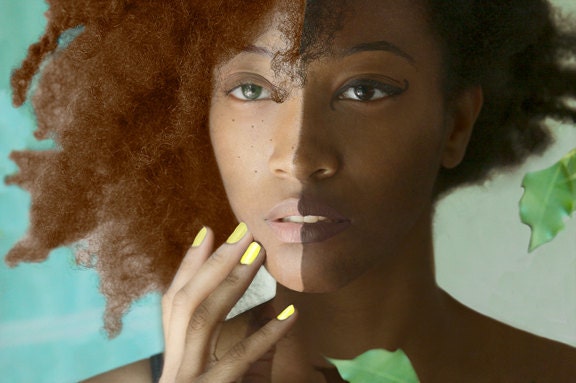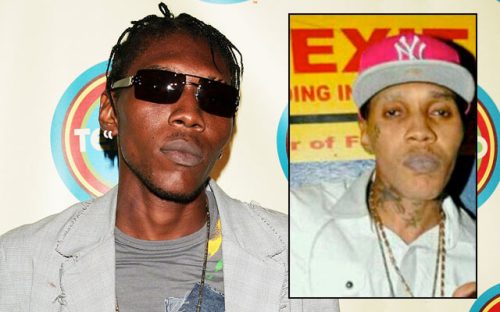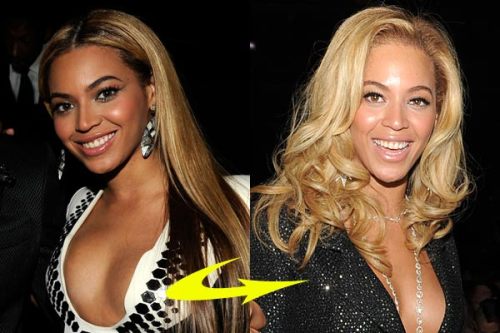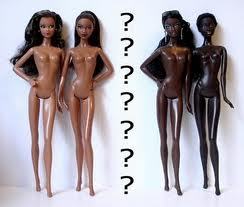
From the Miami Herald, on June 13, 2007, "Black denial" by Frances Robles -- Nearly all Dominican women straighten their hair, which experts say is a direct result of a historical learned rejection of all things black -- SANTO DOMINGO -- Yara Matos sat still while long, shiny locks from China were fastened, bit by bit, to her coarse hair.
Not that Matos has anything against her natural curls, even though Dominicans call that pelo malo -- bad hair.

But a professional Dominican woman just should not have bad hair, she said. "If you're working in a bank, you don't want some barrio-looking hair. Straight hair looks elegant," the bank teller said. "It's not that as a person of color I want to look white. I want to look pretty."
And to many in the Dominican Republic, to look pretty is to look less black.
Dominican hairdressers are internationally known for the best hair-straightening techniques. Store shelves are lined with rows of skin whiteners, hair relaxers and extensions.
Racial identification here is thorny and complex, defined not so much by skin color but by the texture of your hair, the width of your nose and even the depth of your pocket. The richer, the "whiter." And, experts say, it is fueled by a rejection of anything black.
"I always associated black with ugly. I was too dark and didn't have nice hair," said Catherine de la Rosa, a dark-skinned Dominican-American college student spending a semester here. "With time passing, I see I'm not black. I'm Latina.
"At home in New York everyone speaks of color of skin. Here, it's not about skin color. It's culture."
The only country in the Americas to be freed from black colonial rule -- neighboring Haiti -- the Dominican Republic still shows signs of racial wounds more than 200 years later. Presidents historically encouraged Dominicans to embrace Spanish Catholic roots rather than African ancestry.
Here, as in much of Latin America -- the "one drop rule'' works in reverse: One drop of white blood allows even very dark-skinned people to be considered white.

LACK OF INTEREST
As black intellectuals here try to muster a movement to embrace the nation's African roots, they acknowledge that it has been a mostly fruitless cause. Black pride organizations such as Black Woman's Identity fizzled for lack of widespread interest. There was outcry in the media when the Brotherhood of the Congos of the Holy Spirit -- a community with roots in Africa -- was declared an oral patrimony of humanity by UNESCO. "There are many times that I think of just leaving this country because it's too hard," said Juan Rodríguez Acosta, curator of the Museum of the Dominican Man. Acosta, who is black, has pushed for the museum to include controversial exhibits that reflect many Dominicans' African background. "But then I think: Well if I don't stay here to change things, how will things ever change?"
A walk down city streets shows a country where blacks and dark-skinned people vastly outnumber whites, and most estimates say that 90 percent of Dominicans are black or of mixed race. Yet census figures say only 11 percent of the country's nine million people are black.

To many Dominicans, to be black is to be Haitian. So dark-skinned Dominicans tend to describe themselves as any of the dozen or so racial categories that date back hundreds of years -- Indian, burned Indian, dirty Indian, washed Indian, dark Indian, cinnamon, moreno or mulatto, but rarely negro.
The Dominican Republic is not the only nation with so many words to describe skin color. Asked in a 1976 census survey to describe their own complexions, Brazilians came up with 136 different terms, including café au lait, sunburned, morena, Malaysian woman, singed and "toasted."
"The Cuban black was told he was black. The Dominican black was told he was Indian," said Dominican historian Celsa Albert, who is black. "I am not Indian. That color does not exist. People used to tell me, ‘You are not black.' If I am not black, then I guess there are no blacks anywhere, because I have curly hair and dark skin."

THE HISTORY
Using the word Indian to describe dark-skinned people is an attempt to distance Dominicans from any African roots, Albert and other experts said. She noted that it's not even historically accurate: The country's Taino Indians were virtually annihilated in the 1500s, shortly after Spanish colonizers arrived.
Researchers say the de-emphasizing of race in the Dominican Republic dates to the 1700s, when the sugar plantation economy collapsed and many slaves were freed and rose up in society.
Later came the rocky history with Haiti, which shares the island of Hispaniola with the Dominican Republic. Haiti's slaves revolted against the French and in 1804 established their own nation. In 1822, Haitians took over the entire island, ruling the predominantly Hispanic Dominican Republic for 22 years.
To this day, the Dominican Republic celebrates its independence not from centuries-long colonizer Spain, but from Haiti.

"The problem is Haitians developed a policy of black-centrism and . . . Dominicans don't respond to that," said scholar Manuel Núñez, who is black. "Dominican is not a color of skin, like the Haitian."
Dictator Rafael Trujillo, who ruled from 1930 to 1961, strongly promoted anti-Haitian sentiments, and is blamed for creating the many racial categories that avoided the use of the word "black."
The practice continued under President Joaquín Balaguer, who often complained that Haitians were "darkening'' the country. In the 1990s, he was blamed for thwarting the presidential aspirations of leading black candidate José Francisco Peña Gómez by spreading rumors that he was actually Haitian.
"Under Trujillo, being black was the worst thing you could be," said Afro-Dominican poet Blas Jiménez. "Now we are Dominican, because we are not Haitian. We are something, because we are not that."

Jiménez remembers when he got his first passport, the clerk labeled him "Indian." He protested to the director of the agency.
"I remember the man saying, ‘If he wants to be black, let him be black!' '' Jiménez said.
Resentment toward anything Haitian continues, as an estimated one million Haitians live in the Dominican Republic, most working in the sugar and construction industries. Mass deportations often mistakenly include black Dominicans, and Haitians have been periodically lynched in mob violence. The government has been trying to deny citizenship and public education to the Dominican-born children of illegal Haitian migrants.
When migrant-rights activist Sonia Pierre won the prestigious Robert F. Kennedy Human Rights Award in 2006, the government responded by trying to revoke her citizenship, saying she is actually Haitian.
"There's tremendous resistance to blackness -- black is something bad," said black feminist Sergia Galván. ‘‘Black is associated with dark, illegal, ugly, clandestine things. There is a prototype of beauty here and a lot of social pressure. There are schools where braids and natural hair are prohibited."
Galván and a loosely knit group of women have protested European canons of beauty, once going so far as to rally outside a beauty pageant. She and other experts say it is now more common to see darker-skinned women in the contests -- but they never win.

CULTURE PULL
Several women said the cultural rejection of African looking hair is so strong that people often shout insults at women with natural curls.
"I cannot take the bus because people pull my hair and stick combs in it," said wavy haired performance artist Xiomara Fortuna. "They ask me if I just got out of prison. People just don't want that image to be seen."
The hours spent on hair extensions and painful chemical straightening treatments are actually an expression of nationalism, said Ginetta Candelario, who studies the complexities of Dominican race and beauty at Smith College in Massachusetts. And to some of the women who relax their hair, it's simply a way to have soft manageable hair in the Dominican Republic's stifling humidity.

"It's not self-hate," Candelario said. "Going through that is to love yourself a lot. That's someone saying, ‘I am going to take care of me.' It's nationalist, it's affirmative and celebrating self."
Money, education, class -- and of course straight hair -- can make dark-skinned Dominicans be perceived as more "white," she said. Many black Dominicans here say they never knew they were black -- until they visited the United States.
"During the Trujillo regime, people who were dark skinned were rejected, so they created their own mechanism to fight it," said Ramona Hernández, Director of the Dominican Studies Institute at City College in New York. "When you ask, ‘What are you?' they don't give you the answer you want . . . saying we don't want to deal with our blackness is simply what you want to hear."
Hernández, who has olive-toned skin and a long mane of hair she blows out straight, acknowledges she would "never, never, never'' go to a university meeting with her natural curls.
"That's a woman trying to look cute; I'm a sociologist," she said.
Asked if a black Dominican woman can be considered beautiful in her country, Hernández leapt to her feet.
"You should see how they come in here with their big asses!'' she said, shuffling across her office with her arms extended behind her back, simulating an enormous rear-end. "They come in here thinking they are all that, and I think, 'doesn't she know she's not really pretty?' "


The exact same doll at Walmart, but the brown doll is marked down 50%
Maria Elena Polanca is a black woman with the striking good looks. She said most Dominicans look at her with curiosity, as if a black woman being beautiful were something strange.
She spends her days promoting a hair straightener at La Sirena, a Santo Domingo department store that features an astonishing array of hair straightening products.
"Look, we have bad hair, bad. Nobody says 'curly.' It's bad," she said. "You can't go out like that. People will say, 'Look at that nest! Someone light a match!'

Purdue University professor Dawn Stinchcomb, who is African American, said that when she came here in 1999 to study African influences in literature, people insulted her in the street.
Waiters refused to serve her. People wouldn't help Stinchcomb with her research, saying if she wanted to study Africans, she'd have to go to Haiti.
"I had people on the streets . . . yell at me to get out of the sun because I was already black enough," she said. "It was hurtful. . . . I was raised in the South and thought I could handle any racial comment. I never before experienced anything like I did in the Dominican Republic.
"I don't have a problem when people who don't look like me say hurtful things. But when it's people who look just like me?" (source:Miami Herald )

RON'S RANT: Some might say, who cares about the negrophobic colorism that plagues not only the Dominican Republic, but most of the former slave trading colonies around the world. One could argue that this anti-blackness racial heresy represents a post-colonial Stockholm syndrome of white over black. Or, one can plainly see that when the shackles of slavery are removed the formerly oppressed become mirror images of their oppressors.
Certainly if you follow the thinking that black = bad and white = good, then white supremacy and white privilege shall reign forever. After all, one can bleach their skin, and straighten their hair, but their genetic makeup can't be altered. The Dominicans color prejudice just enslaves themselves to a developing world status in perpetuity, because they allow a space for white rule to dominate permanently in their country. Unfortunately, a brown nation infected with the pathology of the whiter the better just begs to be marginalized on the world stage.





The only country in the Americas to be freed from black colonial rule -- neighboring Haiti --
ReplyDeletethis statement is totally false by no means did dominican republic free it self from black colonial rule because haiti were not colonizers haitians were abolitionist and revolutionaries
i am a dominican 10000000% i would never be confused for anything other than black and i know my history
the reason why haiti invaded dr was to free the dominican black slaves and abolish slavery on the island as a whole so for a country with an 85-90% population of color to be celebrating independence from haiti is like african americans getting angry with abolitionist for wanting to free them from slavery it makes no sence what so ever
before posting information make sure its not ignorant and incorrect
IF the history of the Dominican Republic's Independence, THEN please CORRECT THE OFFICIAL RECORDS.
DeleteAccording to Dominican Today, as reported on 27 February 2013, 6:48 AM, in an article entitled, "Dominicans celebrate Independence Day" --
Santo Domingo.– Today the Dominican Republic celebrates its 169 anniversary of Independence from the Haitians.
All official and most private business activities will be suspended.
Today, president Danilo Medina will go to the Congress, to deliver his State of the Nation speech. (source: http://www.dominicantoday.com/dr/local/2013/2/27/46836/Dominicans-celebrate-Independence-Day)
You'd think that the folks at a newspaper named "Dominican Today" would have a handle on their own history. Or, maybe the folks over in the Dominican Republic would have the historical decency to correct their Wikipedia Page that states: "The Dominican Independence War gave the Dominican Republic independence from Haiti in 1844. Before the war, the whole island of Hispaniola had been under Haitian rule for 22 years when Haiti occupied the newly independent state of Haití Español in 1822." (http://en.wikipedia.org/wiki/Dominican_War_of_Independence)
Moreover, the ONLY the Taino and Arawaks are the ingeniousness people from that island, call it what you may (Hispaniola, Saint-Domingue, Santo Domingo, Haiti, Dominican Republic, Hayti, Ayiti or Kiskeya) everybody else was "imported" from another Continent.
Thanks for visiting this site and commenting. Perhaps you should correct your Wikipedia Page.
--Ron Edwards, US Slave Blog